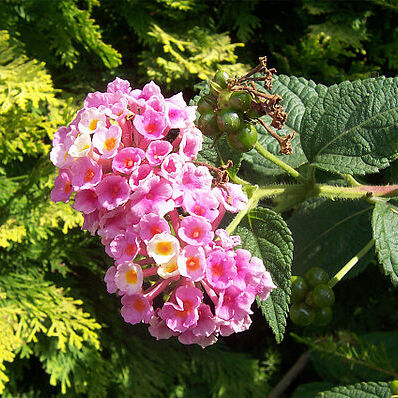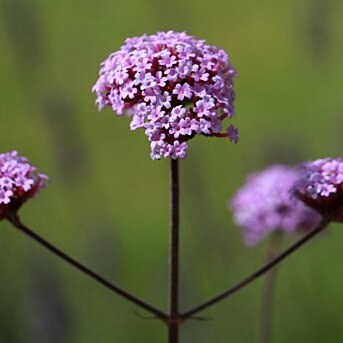Herbs, shrubs, trees or sometimes woody climbers. Leaves opposite and usually decussate, sometimes whorled or rarely (not in Australia) alternate, simple or digitate, exstipulate. Inflorescence racemose, dense or lax, sometimes spicate or a compact head, axillary and/or terminal, simple or compound. Flowers zygomorphic, rarely subactinomorphic, bisexual, rarely plants dioeciousl. Calyx persistent, gamosepalous, truncate, toothed or lobed, (2-or) 4-or 5-lobed. Corolla gamopetalous, with 4 or 5-lobed, rarely truncate; lobes ±2-lipped or nearly equal, imbricate in bud. Stamens inserted in corolla tube and alternate with lobes, 4 in pairs (rarely 5), nearly equal, or reduced to 2, sometimes with 1 or more staminodes; anthers bilocular, dehiscing longitudinally. Ovary superior, bicarpellate (or 1 carpellate by abortion) or 4 carpellate (in Duranta), syncarpous, not lobed or slightly lobed, with 1 or 2 ovules per locule; placentation axile or free-central; style terminal; ovules anatropous, rarely hemianatropous, or subanatropous, or orthotropous, basal, lateral or pendulous. Fruit a dry or fleshy schizocarp, separating at maturity into 2 or 4 1-seeded mericarps or a drupaceous fruit with 1 or 2 or 4 pyrenes. Seeds 1 or 2 per locule, or fewer by abortion; embryo straight; with or without endosperm.
Shrubs or trees, sometimes climbing shrubs, rarely herbs. Indumentum of simple, stellate, and/or other complex hairs. Leaves opposite or rarely whorled, without stipules, simple or 3-foliolate, less often palmately [or pinnately] compound. Inflorescences terminal or axillary, racemose, cymose, spicate, or thyrses. Flowers bisexual or polygamous by abortion, zygomorphic or rarely actinomorphic. Calyx persistent. Corolla 4-or 5-or more lobed; lobes usually spreading, aestivation overlapping. Fertile stamens inserted on corolla tube, alternate with lobes; filaments free; anthers dorsifixed, 1-or 2-locular, dehiscing by longitudinal slits or sometimes a circular pore. Ovary entire or 4-grooved, 2-8-locular; ovules 1 or 2 per locule, erect or pendulous. Style terminal, simple, entire or 2-cleft. Fruit a drupe or indehiscent capsule, sometimes breaking up into nutlets. Seeds (1 or)2-4, endosperm usually absent, seed coat thin; embryo straight, as long as seed; radicle short, inferior.
Gynoecium of 1 pistil, 2-carpellate, though sometimes reduced to one; ovary superior, 2-locular but typically appearing 4-locular due to ovary wall intrusions (false septa), usually slightly to moderately 4-lobed[a2] ; ovules 1 in each apparent locule, usually anatropous, erect, placentation axile with ovules attached to the margin of the false septum (directly to carpel margins, not sub terminal); style 1, terminal; stigma 1, capitate or lobed
Corolla gamopetalous, hypocrateriform (with very narrow tube and abruptly spreading limb), funnel-shaped in Verbena, 5-lobed[a1] , often somewhat bilabiate (with a 2-lobed upper lip and 3-lobed lower lip), variously coloured
Fruit a drupe with 2 or 4 pyrenes, or a schizocarp splitting into 2 or 4 nutlets (mericarps), enclosed or subtended by persistent calyx; endosperm absent; embryo straight, oily
Flowers zygomorphic, hermaphrodite, hypogynous, usually with an inconspicuous nectariferous disk, each solitary in the axil of a single bract, sessile or pedicellate
Annual or perennial herbs or shrubs, rarely trees or vines, often aromatic, sometimes armed with prickles and/or spines
Calyx gamosepalous, persistent, campanulate or tubular, 5-lobed or 5-toothed, sometimes expanded or inflated in fruit
Stamens 4, didynamous, epipetalous; filaments distinct; anthers dorsifixed, dehiscing longitudinally, introrse
Stamens on the corolla, 4 or rarely 2 or 5; anthers 2-celled, cells often divergent, opening lengthwise
Inflorescence indeterminate, terminal or axillary, lax or condensed, racemose, spicate or capitate
Leaves simple, opposite or sometimes whorled; lamina entire or serrate to lobed; stipules absent
Leaves usually opposite or whorled, simple or compound; stipules absent
Corolla gamopetalous, tubular, 4-5-lobed, lobes imbricate
Herbaceous or woody, often with quadrangular branchlets
Seeds with straight embryo and scanty or no endosperm
Ovary superior, 2-8-celled, often 4-celled
Stems frequently square in cross section
Calyx 4-5-lobed or toothed, persistent
Flowers hermaphrodite, zygomorphic
Fruit a drupe or berry
Style terminal, simple


